英语9种时态对比
英语16种时态及区别
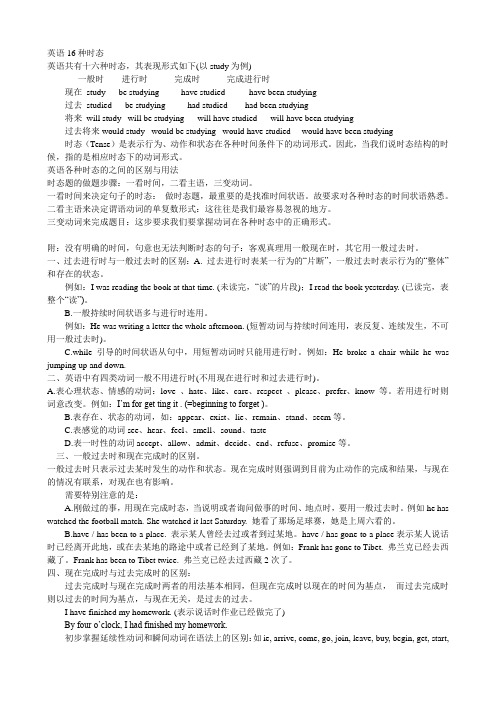
英语16种时态英语共有十六种时态,其表现形式如下(以study为例)一般时进行时完成时完成进行时现在study be studying have studied have been studying过去studied be studying had studied had been studying将来will study will be studying will have studied will have been studying过去将来would study would be studying would have studied would have been studying时态(Tense)是表示行为、动作和状态在各种时间条件下的动词形式。
因此,当我们说时态结构的时候,指的是相应时态下的动词形式。
英语各种时态的之间的区别与用法时态题的做题步骤:一看时间,二看主语,三变动词。
一看时间来决定句子的时态:做时态题,最重要的是找准时间状语。
故要求对各种时态的时间状语熟悉。
二看主语来决定谓语动词的单复数形式:这往往是我们最容易忽视的地方。
三变动词来完成题目:这步要求我们要掌握动词在各种时态中的正确形式。
附:没有明确的时间,句意也无法判断时态的句子:客观真理用一般现在时,其它用一般过去时。
一、过去进行时与一般过去时的区别:A. 过去进行时表某一行为的“片断”,一般过去时表示行为的“整体”和存在的状态。
例如:I was reading the book at that time. (未读完,“读”的片段);I read the book yesterday. (已读完,表整个“读”)。
B.一般持续时间状语多与进行时连用。
例如:He was writing a letter the whole afternoon. (短暂动词与持续时间连用,表反复、连续发生,不可用一般过去时)。
C.while 引导的时间状语从句中,用短暂动词时只能用进行时。
16种英语时态(经典收藏版),太全了!
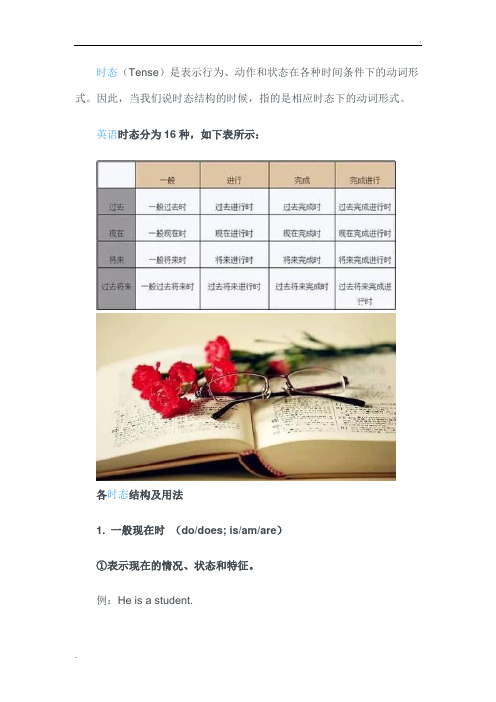
时态(Tense)是表示行为、动作和状态在各种时间条件下的动词形式。
因此,当我们说时态结构的时候,指的是相应时态下的动词形式。
英语时态分为16种,如下表所示:各时态结构及用法1. 一般现在时(do/does; is/am/are)①表示现在的情况、状态和特征。
例:He is a student.他是一个学生。
②表示经常性、习惯性动作。
例:He always helps others.他总是帮助别人。
③客观事实和普遍真理。
例:The earth moves the sun.地球绕着太阳转。
④表示一个按规定、计划或安排要发生的动作。
(常用于列车、客车、飞机或轮船时刻表)例:The next train leaves at 3 o'clock this afternoon.下一趟火车今天下午3点开车。
⑤主将从现:在时间、条件和让步状语从句中经常用一般现在表示将的来事情。
例:If it rains tomorrow, we will stay at home.如果明天下雨,我们会待在家里。
2. 现在进行时(am/is/are doing)①表示此时此刻正在发生的事情。
例:He is listning to the music now.他现在正在听音乐。
②表示目前一段时间内一直在做的事情,但不一定此时此刻正在做。
例:I am studying by using Qisu English APP this term.这个学期我一直在使用奇速英语APP学习。
③现在进行时可以表示将来的含义。
瞬时动词的进行一定表将来。
例:I am leaving.我要离开了。
持续动词的进行只有有将来的时间状语或有将来语境中才表将来。
例:I am travelling next month.下个月我要去旅行。
④现在进行时与频度副词连用,表示说话者或褒义或贬义的感情色彩。
例:He is always helping others.他总是帮助别人。
初中英语导学:初中英语动词时态和语态辨析
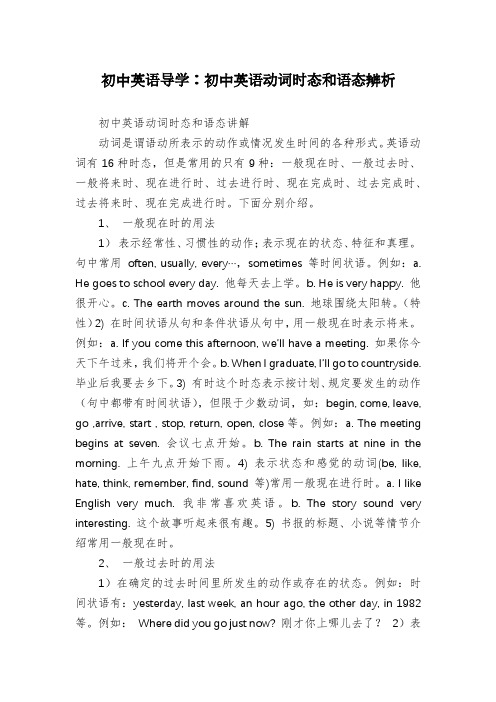
初中英语导学:初中英语动词时态和语态辨析初中英语动词时态和语态讲解动词是谓语动所表示的动作或情况发生时间的各种形式。
英语动词有16种时态,但是常用的只有9种:一般现在时、一般过去时、一般将来时、现在进行时、过去进行时、现在完成时、过去完成时、过去将来时、现在完成进行时。
下面分别介绍。
1、一般现在时的用法1)表示经常性、习惯性的动作;表示现在的状态、特征和真理。
句中常用often, usually, every…,sometimes 等时间状语。
例如:a. He goes to school every day. 他每天去上学。
b. He is very happy. 他很开心。
c. The earth moves around the sun. 地球围绕太阳转。
(特性)2) 在时间状语从句和条件状语从句中,用一般现在时表示将来。
例如:a. If you come this afternoon, we’ll have a meeting. 如果你今天下午过来,我们将开个会。
b. When I graduate, I’ll go to countryside. 毕业后我要去乡下。
3) 有时这个时态表示按计划、规定要发生的动作(句中都带有时间状语),但限于少数动词,如:begin, come, leave, go ,arrive, start , stop, return, open, close等。
例如:a. The meeting begins at seven. 会议七点开始。
b. The rain starts at nine in the morning. 上午九点开始下雨。
4) 表示状态和感觉的动词(be, like, hate, think, remember, find, sound 等)常用一般现在进行时。
a. I like English very much. 我非常喜欢英语。
b. The story sound very interesting. 这个故事听起来很有趣。
英语九大时态总结表格

英语九大时态总结表格时态概述英语中共有九种时态,它们分别是:一般现在时、一般过去时、一般将来时、现在进行时、过去进行时、将来进行时、现在完成时、过去完成时和将来完成时。
这些时态的正确使用对于表达正确的时间和语义非常重要。
以下是对每种时态的简要总结。
时态使用场景例句一般现在时表示经常性或普遍真理I go to school every day.一般过去时表示过去发生的事情She watched a movie last night.一般将来时表示将来发生的事情They will travel to France next week.现在进行时表示现在进行的动作I am studying for my exams.过去进行时表示过去某个时间段内进行的动作He was working late yesterday.将来进行时表示将来某个时间段内进行的动作They will be having dinner at 8 PMtomorrow.现在完成时表示过去的动作对现在造成的影响She has already eaten lunch.过去完成时表示过去的动作对过去的另一个动作造成的影响I had already finished my homeworkwhen she called.将来完成时表示将来某个时间点之前已经完成的动作By this time next month, I will havegraduated.时态详解一般现在时一般现在时用于表示经常性的动作、习惯、事实或普遍的真理。
它使用动词的原形(不带s、es等变化)。
例如:•I go to school every day.•He speaks English fluently.•Dogs bark.一般过去时一般过去时用于表示过去发生的事情或状态。
它使用动词的过去式形式。
例如:•She watched a movie last night.•They lived in that house for five years.•I didn’t see him yesterday.一般将来时一般将来时用于表示将来要发生的事情。
总结英语9大时态(合集20篇)
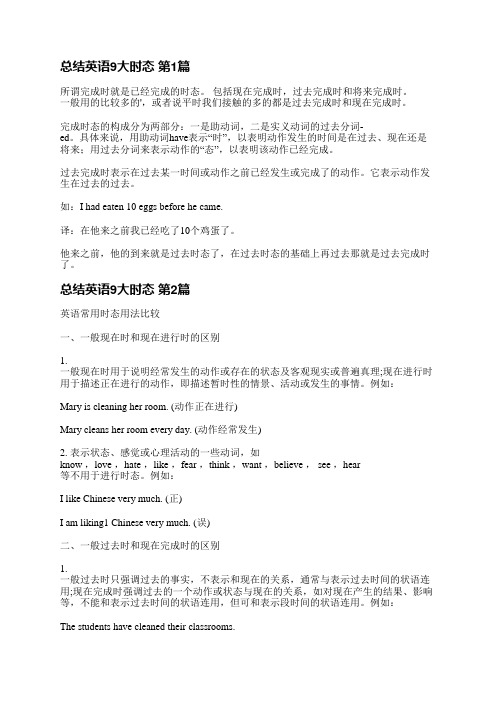
总结英语9大时态第1篇所谓完成时就是已经完成的时态。
包括现在完成时,过去完成时和将来完成时。
一般用的比较多的',或者说平时我们接触的多的都是过去完成时和现在完成时。
完成时态的构成分为两部分:一是助动词,二是实义动词的过去分词-ed。
具体来说,用助动词have表示“时”,以表明动作发生的时间是在过去、现在还是将来;用过去分词来表示动作的“态”,以表明该动作已经完成。
过去完成时表示在过去某一时间或动作之前已经发生或完成了的动作。
它表示动作发生在过去的过去。
如:I had eaten 10 eggs before he came.译:在他来之前我已经吃了10个鸡蛋了。
他来之前,他的到来就是过去时态了,在过去时态的基础上再过去那就是过去完成时了。
总结英语9大时态第2篇英语常用时态用法比较一、一般现在时和现在进行时的区别1.一般现在时用于说明经常发生的动作或存在的状态及客观现实或普遍真理;现在进行时用于描述正在进行的动作,即描述暂时性的情景、活动或发生的事情。
例如:Mary is cleaning her room. (动作正在进行)Mary cleans her room every day. (动作经常发生)2. 表示状态、感觉或心理活动的一些动词,如know ,love ,hate ,like ,fear ,think ,want ,believe , see ,hear等不用于进行时态。
例如:I like Chinese very much. (正)I am liking1 Chinese very much. (误)二、一般过去时和现在完成时的区别1.一般过去时只强调过去的事实,不表示和现在的关系,通常与表示过去时间的状语连用;现在完成时强调过去的一个动作或状态与现在的关系,如对现在产生的结果、影响等,不能和表示过去时间的状语连用,但可和表示段时间的状语连用。
例如:The students have cleaned their classrooms.(表示现在的教室是窗明洁净的)The students cleaned their classrooms yesterday. But it is dirty now.(表示昨天教室是干净的,现在又脏了)2. 现在完成时的谓语动词是瞬间动词时,不能跟表示段时间的状语连用。
英语八大时态讲解

英语八大时态讲解
英语的八大时态包括:一般现在时,一般过去时,现在进行时,过去进行时,一般将来时,过去将来时,现在完成时,过去完成时。
以下是每个时态的详细讲解:
一般现在时:表示经常性或习惯性动作,常与表频度的时间状语连用,如She often speaks English。
也可以表示现在的状态、特征、职业、能力、感觉等,如He seems to feel a bit down today。
此外,它还可以表示真理、客观存在、科学事实或用于格言警句中,如Shanghai lies in the east of China。
一般过去时:表示发生在过去的动作或存在的状态,通常与表示过去的时间状语yesterday,last night,some years ago,in 1990等连用。
现在进行时:表示正在进行的动作或存在的状态,如I am studying now。
过去进行时:表示在过去某个时间点正在进行的动作或存在的状态,如She was studying at 8 o’clock yesterday。
一般将来时:表示将来要发生的动作或存在的状态,如I will go to school tomorrow。
过去将来时:表示在过去某个时间点看来将要发生的动作或存在的状态,如She said she would come to see me the next day。
现在完成时:表示过去发生的动作持续到现在,并可能继续下去,如I have studied English for 5 years。
过去完成时:表示在过去某个时间点之前已经完成的动作或存在的状态,如He said he had finished his homework。
英语十六种时态总结
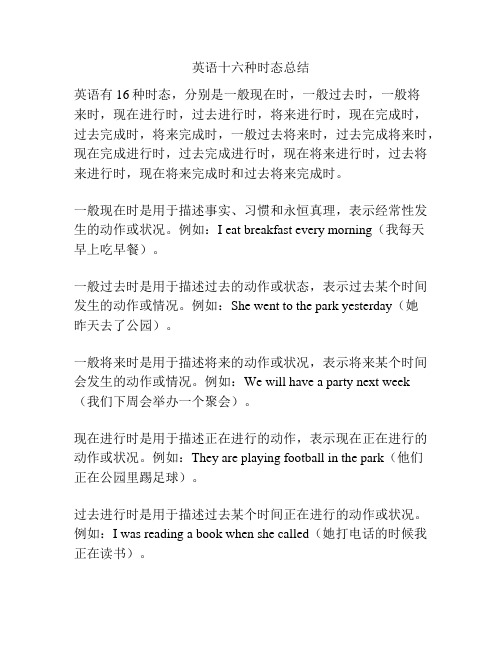
英语十六种时态总结英语有16种时态,分别是一般现在时,一般过去时,一般将来时,现在进行时,过去进行时,将来进行时,现在完成时,过去完成时,将来完成时,一般过去将来时,过去完成将来时,现在完成进行时,过去完成进行时,现在将来进行时,过去将来进行时,现在将来完成时和过去将来完成时。
一般现在时是用于描述事实、习惯和永恒真理,表示经常性发生的动作或状况。
例如:I eat breakfast every morning(我每天早上吃早餐)。
一般过去时是用于描述过去的动作或状态,表示过去某个时间发生的动作或情况。
例如:She went to the park yesterday(她昨天去了公园)。
一般将来时是用于描述将来的动作或状况,表示将来某个时间会发生的动作或情况。
例如:We will have a party next week(我们下周会举办一个聚会)。
现在进行时是用于描述正在进行的动作,表示现在正在进行的动作或状况。
例如:They are playing football in the park(他们正在公园里踢足球)。
过去进行时是用于描述过去某个时间正在进行的动作或状况。
例如:I was reading a book when she called(她打电话的时候我正在读书)。
将来进行时是用于描述将来某个时间正在进行的动作。
例如:They will be studying English at this time tomorrow(明天这个时候他们将会在学习英语)。
现在完成时是用于描述过去发生的动作对现在产生的影响,表示动作从过去一直持续到现在或与现在有关的过去动作。
例如:I have lived in this city for five years(我在这个城市已经住了五年)。
过去完成时是用于描述过去某个时间点之前已经完成的动作,表示过去某个动作发生之前已经完成了的动作。
例如:He had already left when I arrived(当我到达时,他已经走了)。
16种时态表格

16种时态表格时态(Tense)是英语中最基本的语法概念之一,用来描述动作或状态在时间上的情况。
在英语中,一共有16种时态,包括简单时态、进行时态、完成时态和完成进行时态。
下面是对这16种时态的详细介绍:1. 简单现在时(Simple Present)表示经常、习惯性或客观真实存在的动作或状态。
2. 简单过去时(Simple Past)表示过去的动作或状态。
3. 简单将来时(Simple Future)表示将要或即将发生的动作或状态。
4. 现在进行时(Present Continuous)表示现在进行或正在进行的动作。
5. 过去进行时(Past Continuous)表示过去某一时刻正在进行的动作。
6. 将来进行时(Future Continuous)表示将来某一时刻正在进行的动作。
7. 现在完成时(Present Perfect)表示过去某个时候开始并一直持续到现在的动作或状态。
8. 过去完成时(Past Perfect)表示过去某个时刻之前就已经完成的动作或状态。
9. 将来完成时(Future Perfect)表示将来某个时刻之前就已经完成的动作或状态。
10. 现在完成进行时(Present Perfect Continuous)表示在过去某个时刻开始并一直持续到现在的动作。
11. 过去完成进行时(Past Perfect Continuous)表示在过去某个时刻开始并一直持续到另一个过去的时刻的动作。
12. 将来完成进行时(Future Perfect Continuous)表示在将来某个时刻前一直持续的动作。
13. 第一种条件句(First Conditional)表示假设的情况,如果条件成立,那么结果就是这样,否则结果就是另外一种情况。
14. 第二种条件句(Second Conditional)表示虚拟的情况,如果现在或未来的情况是不可能或不可能实现的,那么该怎么样。
15. 第三种条件句(Third Conditional)表示实现不可能的过去情况的结果。
【整理】英语16种时态表

【整理】英语16种时态表一、一般现在时一般现在时表示经常发生或习惯性的动作、状态或真理。
其结构为:主语 + 动词原形(第三人称单数加s/es)。
例句:He goes to school bike every day.(他每天骑自行车上学。
)二、一般过去时一般过去时表示过去某个时间发生的动作或存在的状态。
其结构为:主语 + 动词过去式。
例句:I visited the Great Wall last year.(去年我参观了长城。
)三、一般将来时一般将来时表示将来某个时间会发生的动作或存在的状态。
其结构为:will + 动词原形。
例句:She will graduate from college next year.(她明年将大学毕业。
)四、现在进行时现在进行时表示正在进行的动作或状态。
其结构为:主语 + be动词(am/is/are) + 现在分词。
例句:They are watching a movie in the cinema.(他们正在电影院看电影。
)五、过去进行时过去进行时表示在过去某个时间正在进行的动作或状态。
其结构为:主语 + was/were + 现在分词。
例句:She was reading a book when I called her.(我给她打电话时,她正在看书。
)六、将来进行时将来进行时表示将来某个时间正在进行的动作或状态。
其结构为:will be + 现在分词。
例句:In two hours, we will be sitting in the classroom.(两小时后,我们将坐在教室里。
)七、现在完成时现在完成时表示过去发生的动作对现在造成的影响或结果,常与时间状语since, for, already, yet等连用。
其结构为:主语 +have/has + 过去分词。
例句:She has already finished her homework.(她已经完成了她的家庭作业。
英语九大时态
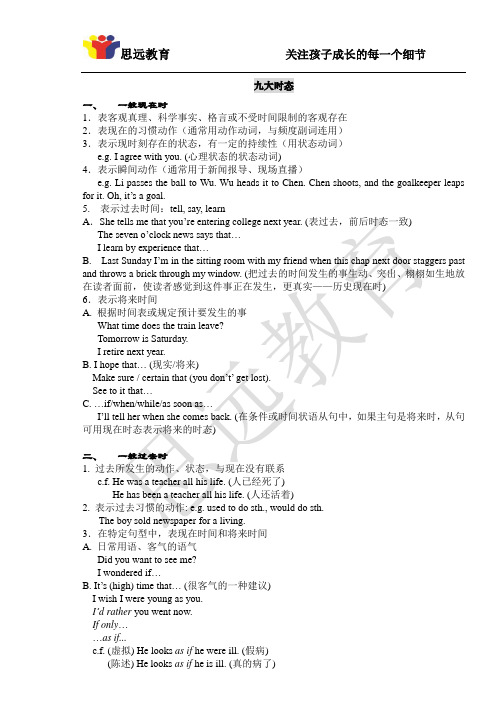
九大时态一、一般现在时1.表客观真理、科学事实、格言或不受时间限制的客观存在2.表现在的习惯动作(通常用动作动词,与频度副词连用)3.表示现时刻存在的状态,有一定的持续性(用状态动词)e.g. I agree with you. (心理状态的状态动词)4.表示瞬间动作(通常用于新闻报导、现场直播)e.g. Li passes the ball to Wu. Wu heads it to Chen. Chen shoots, and the goalkeeper leaps for it. Oh, it’s a goal.5. 表示过去时间:tell, say, learnA.She tells me that you’re entering college next year. (表过去,前后时态一致) The seven o’clock news says that…I learn by experience that…B. Last Sunday I’m in the sitting room with my friend when this chap next door staggers past and throws a brick through my window. (把过去的时间发生的事生动、突出、栩栩如生地放在读者面前,使读者感觉到这件事正在发生,更真实——历史现在时)6.表示将来时间A. 根据时间表或规定预计要发生的事What time does the train leave?Tomorrow is Saturday.I retire next year.B. I hope that… (现实/将来)Make sure / certain that (you don’t’ get lost).See to it that…C. …if/when/while/as soon as…I’ll tell her when she comes back. (在条件或时间状语从句中,如果主句是将来时,从句可用现在时态表示将来的时态)二、一般过去时1. 过去所发生的动作、状态,与现在没有联系c.f. He was a teacher all his life. (人已经死了)He has been a teacher all his life. (人还活着)2. 表示过去习惯的动作: e.g. used to do sth., would do sth.The boy sold newspaper for a living.3.在特定句型中,表现在时间和将来时间A. 日常用语、客气的语气Did you want to see me?I wondered if…B. It’s (high) time that… (很客气的一种建议)I wish I were young as you.I’d rather you went now.If only……as if...c.f. (虚拟) He looks as if he were ill. (假病)(陈述) He looks as if he is ill. (真的病了)I feel as if my head were on fire.Suppose we spent next Sunday in the country.三、一般将来时(一)表示一般将来时的动词形式及用法1.用情态助动词shall/will + 动词原形表示A.表示“预见”——时间B.表示“意图(愿)”,没有将来的意思,有个人感情成分No, I won’t lend it to you.Exception: I’ll give him some advice if he’ll listen to me. (表意愿)为了表纯粹的将来时间,用“will be doing”I will be writing to you soon.2.用“be going to do sth.”表示A. 表示“预见”——有迹象表明,将来某个时刻,将发生某事Be careful! The pile of boxes is going to fall.B. 表示“意图”——经过考虑的,打算在近期做的I’m going to Beijing.How long are you going to stay here?3.用“be doing”表示——按即或安排将发生的动作The plane is taking off at twelve.特点:a. 用时间状语以区别于现在进行时b. 意思靠上下文来理解:Hurry up! The train is starting.4.用“be to do sth.”A. 表示按计划安排We are to learn Chapter Six next week.B. 报纸或电视台宣布官方正规的消息Premier Li is to visit Japan next week.The highway is to open to traffic next Sunday.C.表命令、禁止,没有将来的意思You are to stay here!No one is to leave the classroom without my permission.5.用一般现在时的动词形式表示将来时间(二)各种表示一般将来时的动词形式的用法比较1.Will/shall + 动词原形和be going to结构的比较A. 都表示意图,可互换B.预先经过考虑的,用“be going to”She has bought some cloth. She is going to make herself a dress.C.事先没有考虑的,用“will”表意愿I will go. I will help you.2.be + V.-ing和be going to结构的比较A.表将来,现在已觉得做时,两者可互换B.be + V.-ing: 肯定,不容改变的安排,比较正式be going to:有迹象表面将发生某事3.will/shall+动词原形和将来时表示将来时间的比较If you will (will表意愿,不能略写) kindly wait for a moment, I’ll ask the manager to speak to you.四、现在进行时(一) 用法1.表示说话时正在进行的动作2.表示现阶段正在进行的动作(讲话时不一定在做)(暂时性)3.表计划安排中近期将发生的动作(有时间状语)4.表示刚过去的动作:talk, tell, say5.表示婉转的语气:I’m hoping/wanting/wondering if… (在口语中)6.与always等频度副词连用,表示感情色彩的现阶段发生的动作He’s always finding our faults. (表厌烦)He’s always borrowing money from me and forgetting to pay it back.(二)一般现在时与现在进行时的用法比较1.相对而言,一般现在时表示经常性动作,现在进行时表示暂时性动作I live in Guangzhou. (长期)She’s living in Guangzhou. (读书期间,暂时)2.在报道中,一般现在时表示短暂动作,现在进行时表示持续动作He shoots, and it’s a goal. The crowd is cheering and the other players are running to him to…The bus stops. (一下子停下)The bus is stopping. (慢慢停下)3.一般现在时用来叙述事实,现在进行时含有某种感情色彩(不加频率副词时有赞扬的语气)You are doing fine in school.五、过去进行时1.表示过去某一时间正在进行的动作2.表示过去某段时间的暂时性动作At that time I was teaching in Shaoguang.3.表示按计划安排过去某时将发生的动作(有时间状语)He was leaving a few days later. (表示过去将来时)4.表示婉转口气:want, hope, wonderI was wondering if…5.在某些结构中做想象的用法,表示对现在或将来的设想(虚拟语气)I wish he weren’t speaking so loudly. (与现在事实相反)If they were leaving tonight, I’d like to go with them. (与将来事实相反)6.与频度状语连用,表示感情色彩He was always changing his mind.7.作为铺叙故事情节的背景A man was ferrying across the river when his sword fell into the river.六、现在完成时:have/has + 过去分词(一)不能用的情况:有瞬间动词,有具体的过去时间状语(二)用法1.过去某时发生的动作,其结果和影响现在依然存在I’ve traveled by plane. (有此经历,不确切的过去时间)Do you understand what I have said? (动作的先后)与时间状语连用的情况:A.可以与不确切的过去时间状语连用:already, yet, before, recently, lately..B.可以与频度状语连用:sometimes, ever, never, once, often…C.可以与包括现在时间在内的时间状语连用:this month/morning…,但暗示着另外一个问题The rain has stopped now (=at last).2.(现在)未完成用法:过去发生的动作持续到现在,也许还会持续下去A.与since引导的时间状语连用:since + 名词词组/从句I’ve been here since last July.She has taught us since I came to this school.B.由for引导的时间状语,表一段时间C.可以和其他表示包括现在时间在内的一段时间的时间状语连用:until now, in the past few years, all morning…七、现在完成进行时:have/has + been + V.-ing(一)用法1.表示某一动作从过去某个时刻开始,一直延续到讲话这个时候还在进行2.表示某一动作从过去某个时刻开始,一直延续到讲话这个时候刚刚结束——Sorry I’ve kept you waiting.——That’s all right. I’ve been reading newspapers.(二)现在完成时与现在完成进行时的用法比较1.意义一致,可互用(有时间状语时)2.句子里没有时间状语时:How long have you learned English? (已完成)How long have you been learning English? (未完成)八、过去完成时:had + 过去分词1.表示一个动作或状态在过去某一时间或某一动作之前已经发生(过去的过去)He flew home, but his father had died.2.表示一个动作或状态在过去某一时间之前已经开始,一直延续到这一过去时间还没结束(用段时间的时间状语)By six o’clock, they had worked for 24 hours.She said she had made great progress since she came here.3.想象性用法(虚拟语气)I wish I had gone with you yesterday.4.表示过去未曾实现的希望、愿望、打算:hope, want, think, expect, intend, suppose…We had hoped you would (be able to) go with us.We had wanted to help but couldn’t get there in time.九、过去完成进行时: had been + V.-ing1.表示一个动作从过去某一时间开始,一直延续到另一过去时刻,在那时刻,该动作可能刚结束,也可能还在继续I was tired yesterday when you saw me because I had been playing for 3 hours /since twoo’clock.When I got to the meeting, the speaker had been speaking for an hour.2.通常用于间接引语中。
成人零基础英语常用9种时态
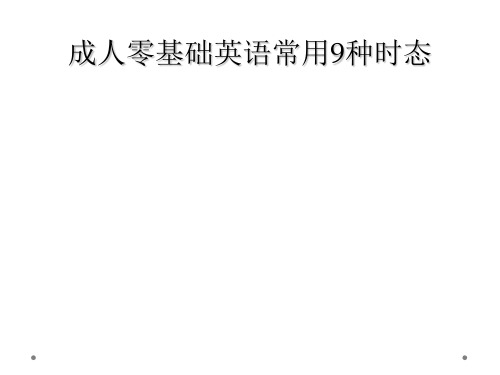
4.现在进展时 be〔am/is/are〕+现在分词
1表示说话此刻或现阶段正在进展的行为 〔时间特征:now, at the moment;动作提示: look〕
We are waiting for you now. Look, they are swimming. we are eating breakfast now. John is watching the baseball game on TV now . 2现阶段的行为——表示长期的动作,说话时动 3作表未示最必近正的在未来进即展将。发生〔动时作间。C特om征e:gtohistatertrmlea,vtehaerrsivee IMdH’ayemybisolse〕yaafvrliinwnegadfyoissr cKcoeomnmtiningpgtltoaoimsneoeinrmrogew. .t抱his怨afternoon.
2〕表示在过去一段时间内,经常性或习惯性的动作。 When I was a child, I often played football in the street.
3〕wish, wonder, think, hope 等用过去时,作试探性的 询问、请求、建议等。 I thought you might have some.
in two days, tomorrow evening By this time tomorrow, I'll be lying on the beach.
7现在完成时 Have/ has +过去分词P.P
1.表示动作已经完成,强调过去发生的某一动作对现在造成的 影响和结果。常与一些时间状语连用:already; this time; ever; recently till now 等。
- 1、下载文档前请自行甄别文档内容的完整性,平台不提供额外的编辑、内容补充、找答案等附加服务。
- 2、"仅部分预览"的文档,不可在线预览部分如存在完整性等问题,可反馈申请退款(可完整预览的文档不适用该条件!)。
- 3、如文档侵犯您的权益,请联系客服反馈,我们会尽快为您处理(人工客服工作时间:9:00-18:30)。
时态的特殊用法
1、主句是一般将来时,时间、条件、让步、方式状语从句须用一般现在时表一般将来时(即主将从现);
主句是过去将来时,时间、条件、让步、方式状语从句须用一般过去时表过去将来时。
(1)I’ll wr ite to her when I have time. (2)If we hurry up, we can catch the bus.
(3)Whatever you say, I won’t pay. (4)Next time I’ll do as he says.
(5)Father told me that he would buy me a computer if he made enough money.
2、主句是将来完成时,从句有by the time 所引导的从句用一般现在时表将来;
主句是过去完成时,从句有by the time、before 所引导的从句用一般过去时。
(1)By the time he comes, I’ll have left.
(2)By the time he came, I had left.
(3)The train had left before we reached the station.
3、by, by the end of后接表将来某一时间的短语用将来完成时;后接表过去某一时间的短语用过去将来时。
(1)By the end of last year, we had produced 20,000 cars.
(2)By 8:00 a.m. yesterday, we had arrived at the park.
(3)By this time next year,I will have graduated from high school.
4、在时间或条件状语从句中,现在完成时可代替一般将来时,表示将来某时完成的动作。
(1)I’ll go to your home when I have finished m y homework.
(2)If you have done the experiment, you will realize the theory better.
5、go\come\leave\start\ arrive等位置移动动词,可以用现在进行时表一般将来时;可以用过去进行时表过去将来时。
(1) I’m leaving tomorrow.(3)Mr. Green was flying to Guangzhou the next week.
(2)They are getting married next week. (4)I didn't know when they were coming again.
6、位移动词如come、go、leave、arrive、fly、start等以here, there开头的句子里,常用一般现在时代替将来时。
(1)There goes the bell. (2)Here she comes.
7、现在进行时或过去进行时常与频度副词always连用,表示说话者表扬、厌烦等感情色彩。
(1)He is always helping others.
(2)He was always thinking of others, never thinking of himself.
8、用于“the+比较级…,the+比较级…”中,前一个用一般现在时表将来,后一个用一般现在时表将来或用一般将来时。
The more you eat, the fatter you (will) become. “越…越…”
9、表示过去经常发生的动作也可用“used to”或“wou ld+动词原形” 代替。
used to + do:“过去常常”表示过去习惯性的动作或状态,但现在不再发生的动作或存在的状态。
would do: 表过去常干某事,但不强调现在不干。
(1)He used to visit his mother once a week.
(2)The old man would sit on a bench in the quiet park .
10、用于think, believe, suppose, plan, expect等心理活动的动词,表示说话人原来没有料到、想到或希望的事,现在时态中通常用过去式,所表达的含义往往与客观事实相反,意为“原想”,“本以为”“本计划”“本期望”等; 过去时态中通常用过去完成时,所表达的含义往往与客观事实相反,意为“原想”,“本以为”“本计划”“本期望”等。
(1)We never thought a team of girls could beat us. This is the most unlucky day of my life.
我们本以为女队绝不可能打败我们,这是我一生中最不幸的日子。
(2)I believed he would not come to see me again. 我本以为他再也不会来看我了。
(3)I had meant to come, but something happened.
11、since后跟从句,表示自从,since后用一般过去时,主句用现在完成时。
(1)He has been in hospital since he became ill.
(2)It’s 3 years since my brother joined the Party.
12、用进行时表示渐变的动词有:get, grow, become, turn, run, go等。
It's getting warmer and warmer.
13、It + be + 一段时间+ before 从句。
这个句式分两种情况:
①如果主句用将来时,则从句用一般现在时表将来时。
意为“多长……以后将会……发生某事”
②如果主句用过去时,从句也用过去时。
意为“多长……后发生了某事。
”
(1)It won’t be long before he succeeds. ( = He will succeed soon.)
(2)It was ten years before they met again. ( = They met again ten years later. )
14、“have been to +地点”与“have gone to+地点”的区别:
★have / has been (to) 表示“曾经去过”某地,说话时此人已经回来了。
He has been to Paris three times.
★have / has gone (to) 表示某人“已经去了”某地,说话的时候,去某地的人不在场,可能到达某地,也可能在去某地的路上,反正不在说话者的身边。
E.g. He has gone to Paris.
15、用于完成时的典型句型:
(1)It/This/That is the first / second , etc, + time…. that从句用现在完成时。
It is the first time that I have visited the city.
(2)It/This/That was the first (second/third…)time+that从句用过去完成时。
It was the first time that I had visited the city.
16、表示“一……就”的几个句型:
(1)Hardly had+主语+过去分词+when +一般过去时。
(2)No sooner had+主语+过去分词+than+一般过去时。
(3)Scarcely had + 主语+ 过去分词+ when + 一般过去时。
①We had hardly heard the news when he cried.
②No sooner had he bought the car than he sold it.。
